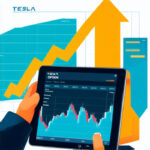How Tesla Trading Is Revolutionizing the Stock Market

Introduction to Tesla Trading
What is Tesla Trading?
Tesla trading refers to the buying and selling of Tesla Inc. (TSLA) stock on various stock exchanges. As one of the most talked-about and volatile stocks, Tesla trading has captured the attention of both institutional and retail investors. The company, known for its electric vehicles, energy storage solutions, and solar products, has become a focal point in the financial markets. Trading Tesla stock can be both exhilarating and challenging due to its frequent price swings and the high level of speculation surrounding its valuation.
Brief History of Tesla in the Stock Market
Tesla Inc. went public on June 29, 2010, with an initial public offering (IPO) price of $17 per share. Since then, the company has experienced significant growth, becoming one of the most valuable automakers in the world. Initially, Tesla faced skepticism from investors due to its ambitious goals and high cash burn rate. However, as the company started delivering on its promises, including the successful launch of electric vehicles like the Model S, Model 3, and Model X, investor confidence grew, propelling its stock to new heights.
Importance of Tesla in Modern Trading
Tesla’s importance in modern trading cannot be overstated. It has become a bellwether for the electric vehicle industry and a symbol of innovation in the stock market. The company’s stock is a favorite among retail investors and has a significant presence in major indices like the NASDAQ and S&P 500. Tesla’s performance often influences the broader market, making it a critical stock for traders and investors to watch. Additionally, its CEO, Elon Musk, is a highly influential figure whose actions and statements can move markets.
The Rise of Tesla Trading
Factors Contributing to Tesla’s Stock Market Surge
Several factors have contributed to Tesla’s stock market surge. First, the growing demand for electric vehicles has positioned Tesla as a leader in the industry. Second, the company’s consistent ability to meet production targets and deliver innovative products has bolstered investor confidence. Third, government incentives and policies favoring clean energy have provided a favorable environment for Tesla’s growth. Lastly, the charismatic leadership of Elon Musk and his vision for the future have attracted a loyal investor base, driving up the stock price.
Impact of Elon Musk’s Leadership
Elon Musk’s leadership has been a driving force behind Tesla’s success. Known for his visionary thinking and relentless pursuit of innovation, Musk has inspired both employees and investors. His hands-on approach and willingness to take risks have led to groundbreaking products and significant advancements in technology. However, Musk’s leadership style is not without controversy, as his tweets and public statements have occasionally led to market volatility. Despite this, his overall impact on the company and its stock performance has been overwhelmingly positive.
Milestones in Tesla’s Trading Journey
Tesla’s trading journey is marked by several key milestones. The company’s IPO in 2010 was the first major event, followed by the launch of the Model S in 2012, which was a critical success. In 2017, Tesla began production of the Model 3, which became one of the best-selling electric cars globally. Another significant milestone was Tesla’s inclusion in the S&P 500 index in December 2020, which led to increased institutional investment. Each of these milestones has contributed to the stock’s meteoric rise and solidified Tesla’s position in the market.
Tesla Trading Technologies
Automated Trading Systems
Automated trading systems have revolutionized Tesla trading by enabling high-frequency trading and reducing the time it takes to execute trades. These systems use complex algorithms to analyze market data and execute trades based on predefined criteria. For Tesla stock, automated trading systems can quickly respond to market movements and news events, providing traders with a significant advantage. As a result, these systems have increased trading volume and liquidity for Tesla shares, making it easier for investors to enter and exit positions.
AI and Machine Learning in Tesla Trading
Artificial intelligence (AI) and machine learning are playing an increasingly important role in Tesla trading. These technologies can analyze vast amounts of data, including market trends, news articles, and social media sentiment, to predict stock movements. For example, AI algorithms can identify patterns in Tesla’s stock price and make recommendations for buy and sell orders. Machine learning models can also continuously improve their accuracy by learning from past trades. This has led to more informed trading decisions and enhanced the overall efficiency of the market.
The Role of Big Data in Tesla Stock Analysis
Big data has become a crucial tool for analyzing Tesla’s stock. By aggregating and analyzing large datasets, investors can gain insights into market trends, consumer behavior, and company performance. For Tesla, big data analysis can include tracking vehicle sales, production numbers, and supply chain information. Additionally, sentiment analysis of social media and news articles can provide real-time insights into public perception of the company. These data-driven insights enable investors to make more informed decisions and better predict future stock movements.
How Tesla Trading is Changing Investor Behavior
Increased Retail Investor Participation
Tesla trading has led to a significant increase in retail investor participation. Many individual investors are drawn to Tesla stock due to its high volatility and potential for substantial returns. The advent of commission-free trading platforms has made it easier for retail investors to buy and sell Tesla shares. This influx of retail investors has contributed to the stock’s price fluctuations and has made Tesla a focal point for online trading communities. As a result, Tesla trading has democratized stock market participation and empowered individual investors.
Social Media Influence on Tesla Trades
Social media has a profound influence on Tesla trades. Platforms like Twitter, Reddit, and YouTube have become hotspots for discussions about Tesla’s stock. Influential figures, including Elon Musk himself, often use social media to communicate with the public, which can lead to immediate market reactions. For instance, Musk’s tweets about Tesla or cryptocurrency can cause significant price movements. Additionally, online communities such as the “r/WallStreetBets” subreddit have mobilized retail investors to collectively buy or sell Tesla stock, amplifying its volatility.
Impact on Long-term vs. Short-term Strategies
Tesla trading has impacted both long-term and short-term investment strategies. Long-term investors are attracted to Tesla’s growth potential and its vision for a sustainable future. They are willing to hold onto the stock despite short-term volatility, believing in its long-term value. On the other hand, short-term traders are drawn to Tesla’s frequent price swings, seeking to profit from rapid fluctuations. This dynamic has created a unique trading environment where both long-term and short-term strategies coexist, each influenced by different factors.
The Financial Impact of Tesla Trading
Market Capitalization and Valuation
Tesla’s market capitalization and valuation have reached unprecedented levels. As of recent years, Tesla’s market cap has surpassed that of traditional automotive giants, making it one of the most valuable companies globally. This high valuation is driven by investor optimism about Tesla’s future growth prospects and its potential to disrupt various industries. However, this lofty valuation also raises questions about whether the stock is overvalued and if it can sustain its current levels. Despite these concerns, Tesla continues to attract significant investor interest.
Tesla’s Influence on the NASDAQ and S&P 500
Tesla’s influence on major stock indices like the NASDAQ and S&P 500 is substantial. Its inclusion in the S&P 500 in December 2020 was a landmark event that led to increased institutional investment. Tesla’s stock performance often impacts the overall movement of these indices, given its significant weighting. As a result, fluctuations in Tesla’s stock price can influence the broader market, affecting not only individual investors but also funds and ETFs that track these indices. This underscores Tesla’s importance in the financial markets.
Effects on Other Automotive Stocks
Tesla trading has also had a ripple effect on other automotive stocks. As Tesla’s market valuation soared, it prompted investors to re-evaluate the potential of traditional automakers and new entrants in the electric vehicle space. Companies like General Motors, Ford, and emerging EV startups have seen increased interest from investors looking to capitalize on the growing demand for electric vehicles. Tesla’s success has forced these companies to accelerate their own EV initiatives, leading to a more competitive and dynamic automotive market.
Risks and Rewards of Tesla Trading
Volatility and Market Speculation
One of the primary risks of Tesla trading is its volatility. The stock is known for its sharp price swings, which can be driven by various factors, including market speculation, news events, and Elon Musk’s public statements. This volatility can lead to significant gains or losses for investors, making Tesla trading both exciting and risky. Speculative trading can amplify these price movements, as traders attempt to capitalize on short-term fluctuations. As a result, investors need to be cautious and consider their risk tolerance when trading Tesla stock.
Regulatory Concerns and Market Manipulation
Regulatory concerns and market manipulation are additional risks associated with Tesla trading. The Securities and Exchange Commission (SEC) has scrutinized Elon Musk’s tweets and public statements, which have sometimes led to legal challenges. Additionally, the high level of retail investor participation and the influence of social media can create opportunities for market manipulation. For example, coordinated buying or selling by online communities can artificially inflate or deflate the stock price. Investors need to be aware of these risks and conduct thorough research before trading Tesla shares.
Potential for High Returns
Despite the risks, Tesla trading offers the potential for high returns. The stock has delivered substantial gains for many investors over the years, driven by the company’s growth and innovation. Those who invested early in Tesla have seen their investments multiply, and even short-term traders have profited from the stock’s volatility. However, it’s essential to approach Tesla trading with a well-thought-out strategy and a clear understanding of the risks involved. By doing so, investors can maximize their chances of achieving high returns while managing potential downsides.
The Future of Tesla Trading
Predictions for Tesla’s Market Performance
Predictions for Tesla’s market performance vary widely among analysts and investors. Some believe that Tesla will continue to dominate the electric vehicle market and expand into new areas such as autonomous driving and energy solutions. This optimistic outlook suggests that Tesla’s stock could continue to rise, delivering substantial returns for investors. Others, however, caution that the stock’s high valuation may not be sustainable and that the company could face challenges from increased competition and regulatory pressures. Ultimately, Tesla’s future market performance will depend on its ability to innovate and execute its vision.
Upcoming Innovations and their Market Impact
Tesla’s upcoming innovations are likely to have a significant impact on its market performance. The company is working on several exciting projects, including the development of fully autonomous vehicles, the expansion of its energy storage solutions, and the launch of the Cybertruck. These innovations have the potential to open new revenue streams and further solidify Tesla’s position as a leader in the technology and automotive sectors. Investors are closely watching these developments, as successful execution could drive the stock to new heights and attract even more interest.
Long-term Investment Potential
Tesla’s long-term investment potential is a topic of much debate. Proponents argue that the company’s focus on innovation and sustainability positions it well for future growth. They believe that Tesla’s leadership in electric vehicles, energy storage, and renewable energy will drive long-term value creation. Critics, however, point to the stock’s high valuation and the challenges of scaling production and maintaining profitability. Regardless of these differing views, Tesla remains a compelling long-term investment for those who believe in its vision and are willing to navigate its inherent risks.
Conclusion
Summary of Tesla Trading’s Impact
Tesla trading has had a profound impact on the stock market, reshaping investor behavior, driving technological advancements, and influencing major stock indices. The company’s innovative products and charismatic leadership have attracted a diverse range of investors, from retail traders to institutional funds. While the stock’s volatility presents risks, it also offers the potential for high returns. As a result, Tesla trading has become a focal point in the financial markets, highlighting the dynamic nature of modern investing.
Final Thoughts on the Future of Stock Market Trading
The future of stock market trading will likely be shaped by companies like Tesla that push the boundaries of innovation and capture the public’s imagination. As technology continues to evolve, we can expect more sophisticated trading tools, increased retail investor participation, and greater influence from social media. Tesla’s journey offers valuable lessons in both the opportunities and challenges of modern trading. By staying informed and adaptable, investors can navigate this ever-changing landscape and capitalize on the exciting possibilities it presents.

Laura Henderson is an enthusiast and has been writing on cutting-edge topics for years.







